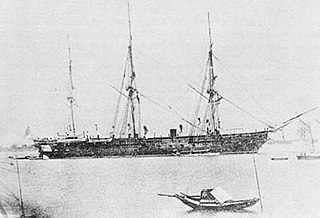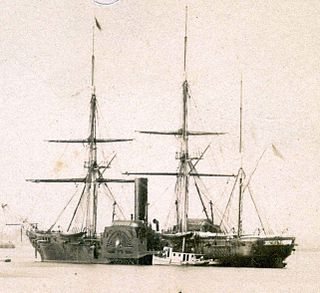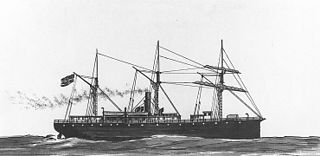
The first USS Colorado, a 3,400-long-ton (3,500 t), three-masted steam screw frigate, was launched on 19 June 1856, by the Norfolk Navy Yard. Named after the Colorado River, she was sponsored by Ms. N. S. Dornin, and commissioned on 13 March 1858, with Captain W. H. Gardner, in command. She was the fifth of the "Franklin-class" frigates, which were all named after US rivers, except for Franklin.

USS Susquehanna, a sidewheel steam frigate, was the first ship of the United States Navy to be named for the Susquehanna River, which rises in Lake Otsego in central New York and flows across Pennsylvania and the northeast corner of Maryland emptying into the Chesapeake Bay.
USS Release was a bark-rigged sailing vessel in the United States Navy during the American Civil War.

The third USS Montgomery was a wooden screw steamer in the Union Navy during the American Civil War.

The first USS Tuscarora was a Mohican-class sloop of war in the United States Navy during the American Civil War.

USS Stars and Stripes was a 407-ton steamer acquired by the U.S. Navy and put to use by the Union during the American Civil War.

The first USS Monticello was a wooden screw-steamer in the Union Navy during the American Civil War. She was named for the home of Thomas Jefferson. She was briefly named Star in May 1861.
The first USS Chocura was a Unadilla-class gunboat which saw service with the U.S. Navy during the American Civil War.

The first USS Jamestown was a sloop-of-war in the United States Navy during the Mexican–American War and the American Civil War.
USS Rachel Seaman was a wooden schooner purchased by the Union Navy during the American Civil War.

USS Huron was a Unadilla-class gunboat built for the United States Navy during the American Civil War for blockage duty against the ports and rivers of the Confederate States of America.

USS Quaker City was a heavy, 1,428 long tons (1,451 t) sidewheel steamship leased by the Union Navy at the start of the American Civil War. She was subsequently purchased by the navy, outfitted with a powerful 20-pounder long rifle, and assigned to help enforce the Union blockade of the ports of the Confederate States of America.

The USS Daylight was a steamship acquired by the Union Navy during the American Civil War. She was used by the Navy to patrol navigable waterways of the Confederacy to prevent the South from trading with other countries.
USS Western World was a ship acquired by the Union Navy during the American Civil War. She was used by the Navy to patrol navigable waterways of the Confederacy to prevent the South from trading with other countries.
USS Restless was a barque acquired by the Union Navy during the American Civil War.
USS Roebuck was a barque used by the Union Navy during the American Civil War.
USS William G. Anderson was a barque used by the Union Navy during the American Civil War. She was assigned by the Navy to patrol navigable waterways of the Confederacy to prevent the South from trading with other countries.
USS Fernandina was a bark purchased by the Union Navy during the American Civil War. She was used by the Union Navy as a patrol vessel, operating in Confederate waterways.
USS State of Georgia was a large steamer with powerful guns acquired by the Union Navy during the American Civil War. State of Georgia, with her crew of 113 sailors and officers, was used by the Union Navy as a gunboat in its blockade of Confederate waterways.
The third USS Union was a heavy (1,114-ton) steamer with a powerful 12-inch rifled gun purchased by the United States Navy during the American Civil War.










